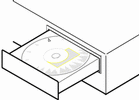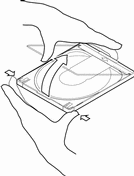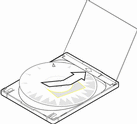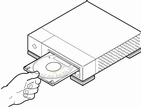To Set Up for Upgrading
-
Do you intend to install the Solaris software through a tip(1) line?
-
If no, go to the next step.
-
If yes, make sure your window display is at least 80 columns wide and 24 rows long.
Note -To determine the current dimensions of your tip window, use the stty(1) command.
-
-
Insert the CD labeled Solaris 8 Installation English SPARC Platform Edition or Solaris 8 Installation Multilingual SPARC Platform Edition into the system's CD-ROM drive.
-
Boot the system by displaying the ok prompt (by typing halt as superuser or by pressing both the Stop and A keys at the same time), and then type:
-
If you're using the CD labeled Solaris 8 Installation English SPARC Platform Edition, information similar to this is displayed:
Boot device: /sbus/espdma@e,8400000/esp@e,8800000/sd@6,0:f File and args: SunOS Release 5.8 Version Generic 32-bit Copyright 1983-2000 Sun Microsystems, Inc. All rights reserved. Configuring /dev and /devices Using RPC Bootparams for network configuration information. Stand by... Solaris Web Start 3.0 installer English has been selected as the language in which to perform the install. Starting the Web Start 3.0 Solaris installer Solaris installer is searching the system's hard disks for a location to place the Solaris installer software. Your system appears to be upgradeable. Do you want to do a Initial Install or Upgrade? 1) Initial Install 2) Upgrade Please Enter 1 or 2 >
-
If you're using the CD labeled Solaris 8 Installation Multilingual SPARC Platform Edition, information similar to this is displayed:
Boot device: /sbus/espdma@e,8400000/esp@e,8800000/sd@6,0:f File and args: SunOS Release 5.8 Version Generic 32-bit Copyright 1983-2000 Sun Microsystems, Inc. All rights reserved. Configuring /dev and /devices Using RPC Bootparams for network configuration information. Stand by... Solaris Web Start 3.0 installer The Solaris Installer can be run in English, or any of the following languages: 1) English 6) Japanese 2) German 7) Korean 3) Spanish 8) Swedish 4) French 9) Simplified_Chinese 5) Italian 10) Traditional_Chinese Select the language you want to use to run the installer:
-
-
-
If the Solaris 8 Installation English SPARC Platform Edition CD, go to the next step.
-
If the Solaris 8 Installation Multilingual SPARC Platform Edition CD, type the number you want to select the language in which to display prompts, messages, and other installation information.
Information similar to this is displayed:
language_you_selected has been selected as the language in which to perform the install. Starting the Web Start 3.0 Solaris installer Solaris installer is searching the system's hard disks for a location to place the Solaris installer software. Your system appears to be upgradeable. Do you want to do a Initial Install or Upgrade? 1) Initial Install 2) Upgrade Please Enter 1 or 2 >
-
-
At the prompt, type 2 for upgrade and press Return.
Solaris Web Start searches the disk for swap slices that meet the minimum size requirements. Information similar to this is then displayed:
Since swap slices are usually erased at each reboot, the Solaris Installer would prefer to place the Solaris install image on a slice labeled swap. The Installer would like to use the disk slice c0t0d0s1, labeled as swap. WARNING: All information will be lost. Can the Solaris Installer use this slice? [y,n,?]
-
Do you want to use the disk slice shown on your screen?
-
If yes, type y and go to Step 14.
-
If no, type n and press Return.
Solaris Web Start searches the disk for slices that meet the minimum size requirements and are not located in any of the "upgradeable" root slices listed in /etc/vfstab, as described in Table 3-1. Information similar to this is displayed:
1) c0t0d0s1 2) Find Another "Find Another" allows the Solaris Installer to find other slices that may meet the criteria found in the Solaris install guide. Please make a selection. >
-
-
Do you want to use the disk slice shown on your screen?
-
If yes, type 1 and go to Step 14.
-
If no, type 2 and press Return.
Solaris Web Start continues looking for another disk slice. If another disk slice is not found, the original swap shown on your screen is used by default. If another disk slice is found, information similar to this is displayed:
The following slices were found to meet the criteria in the Solaris Install Guide. WARNING: If one of the listed slices is chosen to be used by the Solaris Installer all information on the slice will be erased 1) c0t0d0s7 last mounted on /export/home 2) None "None" will skip these disk slices and present you with a listing of all disks on the system Please make a selection from the choices above > -
-
Do you want to use one of the slices shown or None?
Note -If you select None and a disk identifier, you can no longer upgrade the system. You must perform an initial installation.
-
If you want to use one of the slices shown, type the number of the slice you want and go to Step 14.
-
If None, type 2 and press Return.
Information similar to this is displayed:
The default root disk is /dev/dsk/c0t0d0. The Solaris installer needs to format /dev/dsk/c0t0d0 to install Solaris. WARNING: ALL INFORMATION ON THE DISK WILL BE ERASED! Do you want to format /dev/dsk/c0t0d0? [y,n,?,q]
-
-
At the prompt, type y and press Return.
Information similar to this is displayed:
NOTE: The swap size cannot be changed during filesystem layout. Enter a swap slice size between 478MB and 2028MB, default = 512MB [?]
-
At the prompt, press Return to enter the default swap slice size, or type the swap slice size you want and press Return.
Information similar to this is displayed:
The Installer prefers that the swap slice is at the beginning of the disk. This will allow the most flexible filesystem partitioning later in the installation. Can the swap slice start at the beginning of the disk [y,n,?,q]
-
Do you want to place the swap space at the beginning of the disk (and thus improve the flexibility of partitioning the file systems and the efficiency with which the disk is accessed)?
-
If yes, type y and go to Step 14.
-
If no, type n and press Return.
Information similar to this is displayed:
WARNING: Placing the swap slice at a cylinder location other than cylinder 0 requires expert knowledge about disk layout. This choice may affect disk layout choices later in the installation. Enter a starting cylinder between 0 and 2043, default = 0 [?]
-
-
Press Return to enter the default starting cylinder (0), or type the starting cylinder you want and press Return.
Information similar to this is displayed:
You have selected the following to be used by the Solaris installer: Disk Slice : /dev/dsk/c0t0d0 Size : 512 MB Start Cyl. : 0 WARNING: ALL INFORMATION ON THE DISK WILL BE ERASED! Is this OK [y,n,?,q] -
At the prompt, type y.
-
Press Return.
Information similar to this is displayed:
The Solaris installer will use disk slice, /dev/dsk/c0t0d0s1. After files are copied, the system will automatically reboot, and installation will continue. Please Wait... Copying mini-root to local disk....done. Copying platform specific files....done. Preparing to reboot and continue installation. Syncing file systems... 10 done rebooting... Resetting ... Sun Ultra 1 SBus (UltraSPARC 143MHz), Keyboard Present OpenBoot 3.5, 64 MB memory installed, Serial #9999999. Ethernet address 8:0:20:8d:35:a5, Host ID: 808d35a5. Rebooting with command: boot /sbus@1f,0/espdma@e,8400000/esp@e,8800000/sd@0,0:b Boot device: /sbus@1f,0/espdma@e,8400000/esp@e,8800000/sd@0,0:b File and args: SunOS Release 5.8 Version Generic 32-bit Copyright 1983-2000 Sun Microsystems, Inc. All rights reserved. Configuring /dev and /devices Using RPC Bootparams for network configuration information. Stand by...The Welcome screen is displayed:
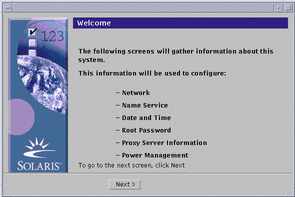
- © 2010, Oracle Corporation and/or its affiliates

